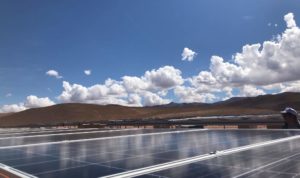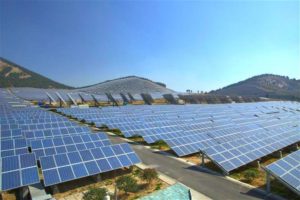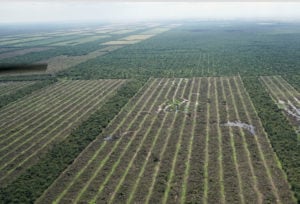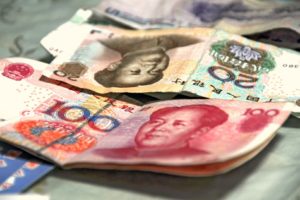In the northern Argentine province of Jujuy, at a dizzying 4,000 metres above sea level, red and blue banners inscribed with Chinese characters flap outside a temporary office perched on a barren desert.
This is Cauchari, the site of Latin America’s largest solar plant. Chinese technology and finance have enabled the project, which is part of Argentina’s plan to boost renewable energy generation. With Argentina struggling to attract foreign investment for infrastructure over the past decade, it has increasingly turned to China, and Cauchari reflects the two countries’ close cooperation.
Chinese banks and companies have developed coal-fired power plants worldwide. Now they are making the foray into cross-border solar energy development. But are projects such as Cauchari exceptional or a sign of a broader shift towards China developing clean energy overseas?
Harnessing the desert sun, with China’s support
Cauchari is a remote site 300 kilometres from San Salvador, Jujuy’s capital. When finished, it will consist of 1.2 million solar panels and provide the grid with 300 megawatts of power, eventually expanding to produce 500 megawatts, making it one of the largest solar plants in the world.
“Cauchari is in the area with the best solar radiation of the world. We also have good weather conditions and low smog, both good for the project,” said Guillermo Giralt, technical director of Cauchari Solar, one of the companies involved in the project.
$US 1 million
in annual profits will be given to the indigenous communities who own the land where Cauchari is located
The Export-Import Bank of China (China Exim) is financing 85% of the project’s US$390 million total cost. The local government will provide the remainder through a green bond.
Provincial energy company JEMSE owns and manages the plant, which is being built by Shanghai Electric Power Construction (SEPC), a subsidiary of the construction group Powerchina. A Chinese firm, Talesun, is also supplying the solar panels.
The government has agreed to provide indigenous communities, who own the land where Cauchari is located, with 2% of its annual profits. This share could equate to up to US$1 million. Community members have also received training and a range of job opportunities at the site, ranging from catering to transportation.
“Our initial condition for the project was for it to have local workers. In order to achieve that, we trained 600 people from nearby towns and then hired them,” said Mario Pizarro, Jujuy’s energy secretary.
The project will likely be finished by May and have a lifespan of 25 years.
Argentina’s clean energy drive
The Cauchari solar plant is expected to cut both energy costs and carbon dioxide emissions. The latter by some 325,000 tonnes. It is one of the largest projects awarded through the RenovAR energy auction, which approved 147 projects with a combined installed capacity of 4,466 megawatts.
“Cauchari represents the success of the RenovAR scheme and shows the potential of renewables in Argentina. We have great green resources with a lot of potential that are starting to come to light,” said congressman Juan Carlos Villalonga, who is head of the Los Verdes green party.
The government has set a target for renewables to account for 20% of the entire energy matrix by 2025. They now account for about 4%. However, the renewables push runs in parallel to the promotion of hydrocarbons extraction through dozens of shale gas and oil projects in the southern region of Patagonia.
Argentina has a huge potential to generate wind power in Patagonia and solar in the north. Resources exist for biogas and biomass in provinces with sizeable agricultural industries. Despite this potential, Argentina lags behind its Latin American neighbours.
The Cauchari solar plant is expected to cut both energy costs and carbon dioxide emissions. The latter by some 325,000 tonnes.
Chilean energy watchdog the National Electric Coordinator (CEN) estimates that solar will account for nearly 10% of the energy mix this year, while wind could hit just over 6%. Meanwhile Uruguay has been consistently growing its share of wind and solar, which accounted for over 44% of its electricity generation in some months last year.
China’s growing presence in Argentina
Argentina enjoys a “strategic integral alliance” with China, a high diplomatic status that the latter confers on only a handful of countries.
Former president Cristina Fernández de Kirchner elevated the level of cooperation by signing dozens of treaties with China, many of them controversial.
In the last decade, Chinese products went from accounting for 5% to 20% of Argentina’s imports. Argentina’s exports to China did not grow at the same rate, increasing from just 8% to around 12% today. This has led to a record trade deficit of more than US$5 billion between the two countries.
Alongside investing in several infrastructure projects such as dams and railways, China has played a key role in the RenovAR scheme. In the first round of bidding, half the winning wind energy projects and three quarters of solar were linked to Chinese capital and technology, according to Carlos Saint James, former head of Argentina’s Renewable Energies Chamber (CADER).
The use of Chinese technology in Argentine energy projects has generated concerns among national industry associations, who fear the incentives offered to foreign companies through programmes such as RenovAR inhibit the use of their own technology.
According to wholesale power administrator Cammesa, Argentine technology accounted for scarcely 10% of the total used in wind energy projects auctioned through RenovAR’s first two rounds.
In the nuclear sector, Argentine president Mauricio Macri met with Chinese counterpart Xi Jinping in December amid expectations the two would approve plants with Chinese finance and reactors. This despite Argentina’s advanced nuclear industry. The project stalled after a group of former environment ministers wrote to the government questioning its economic wisdom.
Chinese banks and companies eye solar
The Cauchari plant is part of a nascent but growing trend of Chinese financiers and companies striking out in the cross-border solar market. Since 2010, China Exim and China Development Bank (CDB), along with a handful of companies, have pursued solar projects globally.
CDB and Exim are state-owned policy banks tasked with supporting the government’s domestic and overseas development agenda. This includes promoting industrial upgrading and building an overseas market for Chinese companies.
To date, the banks have financed a number of large-scale solar projects in developed countries and countries closely integrated with the Belt and Road infrastructure initiative, including Pakistan in 2015.
A World Resources Institute (WRI) and Boston University study found that solar lending made up only 5.6% of China’s major commercial and policy banks’ power generation and transmission portfolio from 2014 to 2017. However, for the two policy banks, that is up from practically zero investment prior to 2010.
Chinese companies have also started to invest in solar projects abroad, both in greenfield development and through mergers and acquisitions. Similar to the banks, solar only constituted 4% of companies’ overseas investments from 2000 to 2017 according to a Princeton and Boston University study.
However, they started to pick up as of 2012. Some of these renewable energy companies have been supported by the same large banks, which have given them significant lines of credit.
Policies pave the way
Alongside Argentina’s strong relationship with China, Cauchari likely appealed to China Exim due to the RenovAR scheme.
According to the Princeton and Boston University study, investment in renewable energy projects by Chinese companies is concentrated in mature markets with strong renewable energy policies, such as the UK, Australia, Brazil and India. Building on China’s domestic solar boom, Chinese banks and companies are well equipped to serve these markets.
Technically everything is possible but if you don’t have the support of the government, nothing will happen
For banks, the policy environment can also have a strong influence on a project’s feasibility. Last year, the China-led Asian Infrastructure Investment Bank made its first solar energy investment in a large solar park in Egypt. Maria del Carmen de Castro Ovejero, a senior investment operations specialist and the bank’s team leader for the Egypt project, said that the country’s policy support for renewable energy enabled the project and the bank’s participation.
“From my point of view as an engineer, technically everything is possible […] but if you don’t have the support of the government, nothing will happen,” she said.
Like Argentina, Egypt has established a feed-in-tariff, guaranteeing developers a minimum price for the solar power they sell back to the grid. Bloomberg New Energy Finance found that building wind and solar photovoltaic plants is already less expensive than building large-scale gas and coal plants. However, policies like Egypt’s and Argentina’s help the new energy industries break into the market and secure financing.
Barriers remain
As renewable energy continues to become cheaper, will projects such as Cauchari replace China’s conventional energy investments overseas?
In developing countries, technical issues continue to pose challenges for large-scale solar development. According to de Castro Ovejero, solar plants are technically simple and quick to develop but integrating plants into the grid can be difficult.
“Solar is normally developed in very remote locations, so it is important that the grid connection is available in order to finance these projects. Grid stability is another issue, especially in developing countries,” she said.
The timeline might be slightly different, but in roughly 10 years, the cost of renewable generation plus storage per kilowatt hour will be on par with fossil fuels or even lower
Clearer renewable energy policies are also needed to drive Chinese investment. The WRI and Boston University study found that only 31 out of 56 countries analysed had concrete renewable energy targets in their Paris Agreement national climate plans.
Even with targets, developing countries can lack the capacity to design and implement specific policies. Laurel Ostfield, head of communications and development for the AIIB, said that the bank has a special fund that can help countries fill that gap.
Fossil fuel inertia
While Chinese banks and companies are making inroads in solar development globally, their overall energy investment portfolios remain heavily skewed toward fossil fuels. The WRI and Boston University study found that between 2014 and 2017, fossil fuel investments accounted for 91% of the energy loan portfolios of the six major banks studied.
91%
of six major Chinese banks' energy loans between 2014 and 2017 were for fossil fuels
Lihuan Zhou, a research analyst at WRI who co-authored the study, said that the Chinese government could send clearer signals on renewables:
“Currently there are several high level Chinese documents, for example issued by the State Council and the Ministry of Ecology and Environment. They have very high-level language on a vision for the green BRI, but on the more operational level there is a lack of policy or incentives for banks to provide green finance overseas.”
Meanwhile, the Chinese government, just like the Argentine, is offering incentives for fossil fuel investment. Yuan Jiahai, a professor at the North China Electricity and Power University, said China’s use of policy loans equates to invisible subsidies for overseas coal projects.
“These projects do not help these countries realise their climate goals and hurt China’s interests in terms of international image and investment risk,” he said, adding; “To be more constructive, China should trade the invisible subsidies for clear development aid to help Belt and Road countries launch renewable energy business development and drive the global energy investment transformation.”
Perhaps a product of the state’s investment priorities, it is privately-owned enterprises that are leading China’s overseas solar investment while state-owned enterprises remain focused on fossil fuel investment.
Solar forecast
When workers lay the final Chinese panels at Cauchari, Argentina will take a leap closer to the renewable energy leaders in the region. Equipped with Chinese technology, developed by a Chinese contractor, and financed by one of China’s largest banks, Cauchari also displays China Inc.’s potential to dominate a new industry.
Whether China will fully embrace foreign solar markets in the near-term remains unclear, but Xiao Wang, an economist at the AIIB, sees the future reflected in the Chinese solar arrays now helping power nations from Egypt to Argentina:
“The timeline might be slightly different, but in roughly 10 years, the cost of renewable generation plus storage per kilowatt hour will be on par with fossil fuel or even lower. So this is a clear direction to move in.”





![Amne Machin, a sacred mountain on the Tibetan plateau, which is changing far quicker than the world realises [image by: Joshua Cohen]](https://dialogue.earth/content/uploads/2019/02/The-Tibetan-plateau-is-changing-far-quicker-than-the-world-realises-300x225.jpg)

![Only a little grass and a few animals grazing near the Deosai National Park [image by: Amar Guriro]](https://dialogue.earth/content/uploads/2018/09/16-B-300x200.jpg)
